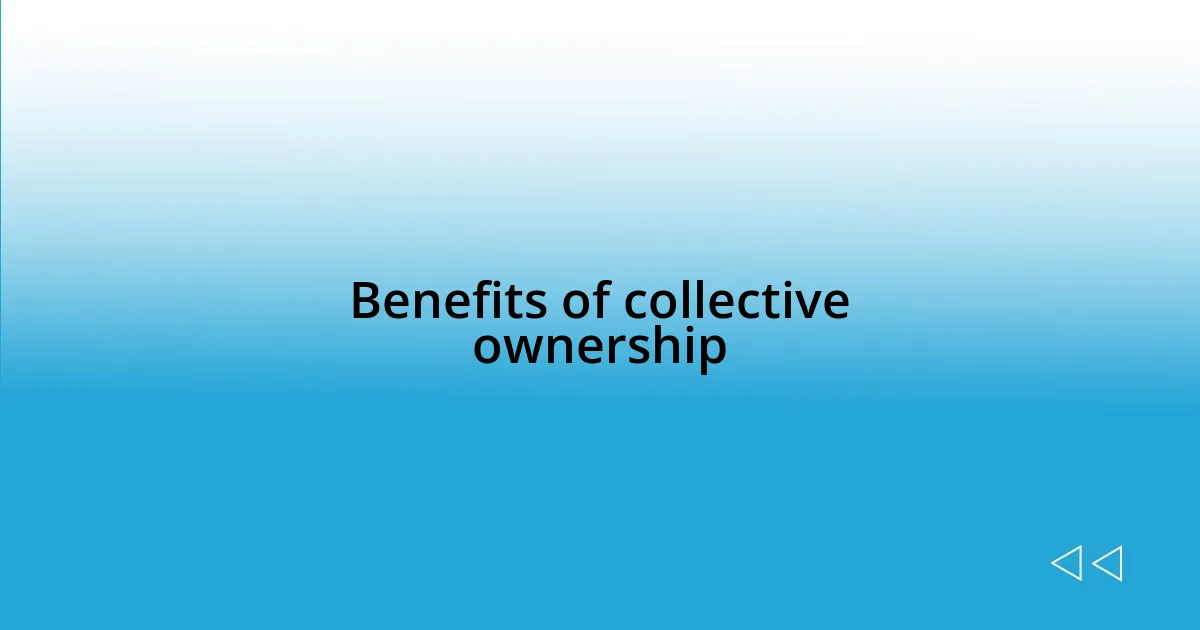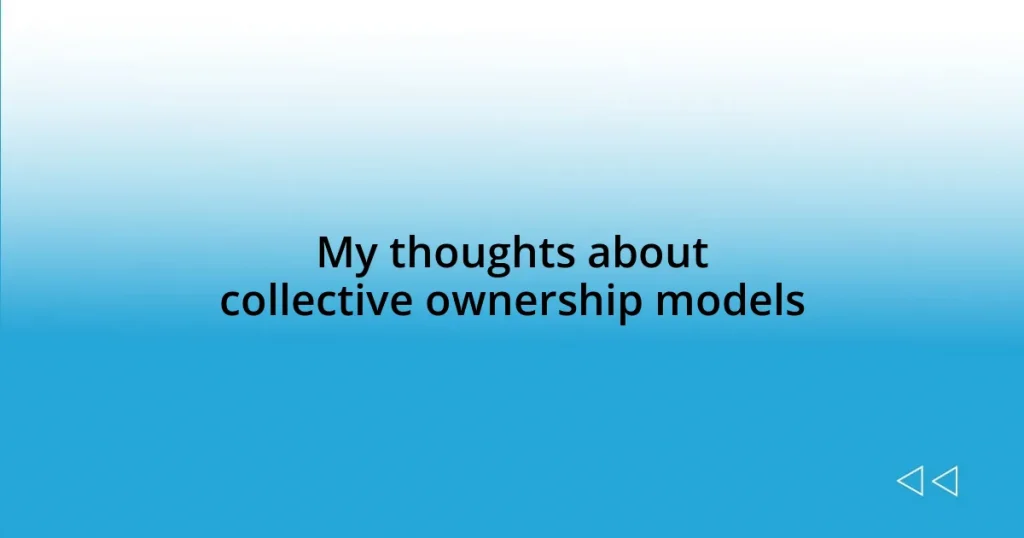Key takeaways:
- Collective ownership models democratize access to resources, fostering community and shared responsibility.
- Key benefits include strengthened community ties, shared decision-making, and equitable resource distribution.
- Challenges such as conflict resolution and role clarity require effective communication and coordination among members.
- Successful examples like co-housing and artist collectives highlight the innovative potential and deep connections formed through collaboration.

Understanding collective ownership models
Collective ownership models are fascinating because they shift the traditional dynamics of ownership from individual possession to shared responsibility and use. I’ve often pondered how this structure not only democratizes access to resources but also fosters a sense of community. Isn’t it interesting how pooling resources can lead to innovation and better decision-making?
I remember being part of a cooperative that managed a community garden. Each person contributed their time and expertise, and it was incredible to witness how ownership transformed our relationships with one another and the land. This model allowed everyone to have a stake in the outcomes, reminding me that satisfaction often grows from shared effort and mutual care.
In essence, collective ownership challenges the notion of profit-driven motives and instead promotes sustainability and equity. Have you ever considered how this approach could reshape industries or local businesses? By placing value on collective success, we not only enhance collaboration but also nurture a deeper connection to the products and services we create together.

Benefits of collective ownership
Collective ownership models bring a multitude of benefits that resonate deeply with my personal experiences. One significant advantage is the way they cultivate a strong sense of community. I can recall a time when I participated in a community-supported agriculture initiative. Everyone involved shared the responsibilities and rewards, which fostered trust and common purpose among us. The joy was palpable during harvest days, as we worked side by side, transforming individual efforts into a collective celebration.
Another compelling benefit is the enhancement of shared decision-making. Instead of a single person’s opinion dictating directions, everyone’s voice holds weight. This reminds me of a collective I joined where we collaborated on local projects. The diverse perspectives we brought forward not only enriched our discussions but often led to far more creative solutions than I had initially envisioned. This experience taught me that when people come together, the outcomes can be unexpectedly powerful and innovative.
Collective ownership also supports equitable distribution of resources, which is vital in today’s society. I’ve seen firsthand how cooperative businesses prioritize the well-being of their members over profit. At a cooperative where I volunteered, every decision reflected our shared values, and profits were reinvested into community initiatives. It’s a refreshing reminder that when we prioritize people over profit, we create a sustainable framework that benefits everyone involved.
| Benefit | Description |
|---|---|
| Strengthened Community | Fosters trust and common purpose among participants, enhancing relationships. |
| Shared Decision-Making | Diverse perspectives lead to innovative solutions through collaborative discussions. |
| Equitable Resource Distribution | Prioritizes member well-being over profit, promoting sustainability and community impact. |

Challenges in collective ownership
Navigating the world of collective ownership isn’t without its hurdles. One challenge I’ve observed is the potential for conflict among members, especially when it comes to decision-making. I recall a time in a group I participated in where differing opinions about resource allocation led to heated debates. Those moments were tough, as they tested our patience and commitment to collaboration. It’s vital to recognize that while shared ownership fosters community, it also requires effective communication skills to manage disagreements.
Another aspect worth noting is the complexity of organizing and maintaining collective structures. Managing logistics can become overwhelming, as each member has their own perspective and priorities. For instance, during my time in a housing co-op, we faced difficulties reaching agreements on maintenance schedules, leading to frustrations and delays. This experience illustrated the importance of clear roles and responsibilities to keep things moving smoothly.
Here are some specific challenges in collective ownership:
- Conflict Resolution: Navigating disagreements can strain relationships and impede progress.
- Decision-Making Complexity: Involving multiple perspectives may slow down the decision-making process.
- Role Clarity: Ambiguity in responsibilities can lead to confusion and inefficiencies.
- Resource Management: Pooling resources requires meticulous tracking and planning to avoid miscommunication.
- Commitment Levels: Variability in member engagement can lead to imbalances in workload and expectations.
Facing these challenges head-on can ultimately strengthen the collective, but it definitely requires intention and effort from everyone involved.

Types of collective ownership structures
When we talk about collective ownership structures, we often find several configurations that cater to the needs of the group. For instance, cooperatives are one of the most recognized forms, where members actively participate in the decision-making process and share the profits. I’ve been a part of a worker cooperative that operated a café, and it was remarkable to see everyone pitching in ideas, from menu changes to marketing strategies. Does it get any better than making decisions together that impact our livelihoods directly? I always felt a deeper connection to the work because it wasn’t just a job; it was our collective passion.
Yet, not all structures function the same way. Community land trusts are another fascinating model, wherein land is collectively owned and managed for the benefit of the community. My friend once lived in an area supported by such a trust, and they were able to create affordable housing options while preserving green spaces. It made me wonder: how much more could we achieve if we had more of these models in our cities? The commitment to sustainability and community welfare that I witnessed there was genuinely inspiring.
Investment collectives are yet another interesting variation. In these groups, members pool their financial resources to invest in various ventures. I remember a fascinating discussion I had with members of an investment club focused on ethical businesses. We all came from different backgrounds, yet our shared values drove us to explore avenues that would not only yield profits but also align with our ethics. This collaborative effort showcased how diverse thoughts can converge to support not just our financial growth but the broader community as well. Doesn’t that just highlight the power of coming together?

Successful examples of collective ownership
Take a look at the co-housing community I visited a couple of years ago. Residents transformed a formerly abandoned building into a vibrant place filled with shared spaces for cooking, gardening, and social gatherings. My heart swelled when I observed how they connected over communal meals, making decisions together about maintenance and events. It struck me that the sense of belonging and shared responsibility was palpable; they weren’t just neighbors, they were a true community.
Another compelling example is the rise of artist collectives in urban areas. I once attended an art installation created by a group of artists who pooled their resources to secure a gallery space. The energy in that room was electric as ideas flourished and everyone had a voice in the creative process. It made me wonder how much more innovative projects could emerge if we embraced this collaborative spirit more widely. Isn’t it fascinating how collaboration can not only enhance creativity but also foster deep connections?
Then there’s the tale of a friends’ farming co-op, where a group of diverse individuals shared not only a plot of land but their skills and experiences. I remember one weekend visit filled with laughter, as we all learned from each other—someone showed me how to plant herbs, while others demonstrated organic pest control. This highlight of community resilience reminded me how collective ownership is not just about sharing resources but also about nurturing friendships and building a network of support, making the entire experience richer and more fulfilling. Wouldn’t you agree that such moments are what make collective ownership so worthwhile?

Strategies for implementing collective ownership
To successfully implement collective ownership, it’s essential to foster a culture of transparency and trust among the members. I recall joining a community project where we held weekly meetings to discuss our progress and challenges openly. This space for honest dialogue made everyone feel valued and invested. Can you imagine how different it feels to contribute when you know your voice is truly heard? That experience taught me that encouraging vulnerability can significantly enhance collaboration.
Education plays a pivotal role in ensuring that all members are on the same page. In one initiative I was involved with, we organized workshops to articulate our collective goals and individual roles clearly. The more knowledge we shared, the more empowered each member became, leading to an invigorated sense of ownership. It struck me how empowering people with understanding can transform passive participants into active contributors. Isn’t it incredible how much a little education can amplify commitment?
Lastly, leveraging technology can streamline communication and facilitate decision-making processes. I’ve seen platforms that allow teams to collaborate in real-time, share resources, and track progress effortlessly. In one co-op I participated in, we used a shared digital board for brainstorming. It was not only efficient but sparked ideas that would have otherwise remained dormant. Have you noticed how technology can bring together diverse perspectives in a way that feels cohesive? This integration can truly enhance the effectiveness of collective ownership, making it accessible and dynamic.
















